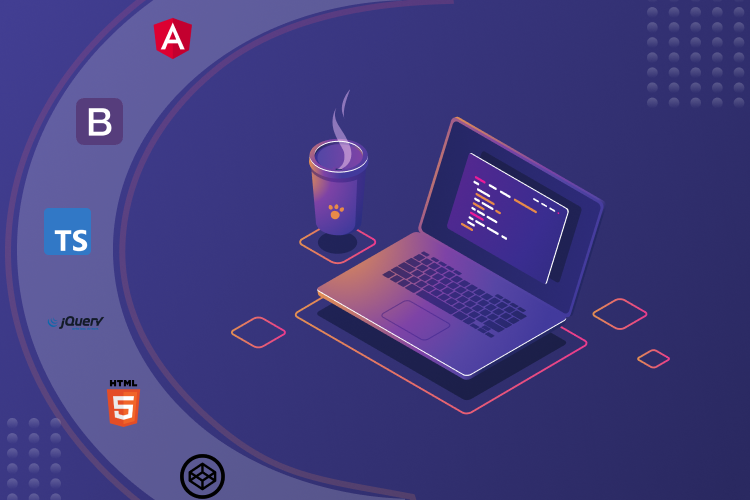Top 12 Frontend Development Tools, Libraries and Frameworks to Use in 2024
- Web
- March 1, 2021
Frontend development tools have become high in demand in only a few years. Due to their progress, you can enhance your workflow and get advantages from better possibilities at the time of creating a responsive website design.
Frontend development tools significantly enhance the process of building scalable and maintainable frontend architecture by streamlining various aspects of the development lifecycle. These tools help developers work with various technologies. Moreover, they offer quicker mobile app development at lower expenses.
Apart from that, you can create things together due to ever-growing version control systems. From browser plugins and add-ons to processors that organize your code, there have not been more opportunities to develop amazing web apps.
However, with the increasing number of web development tools, choosing the right software to do your job can be difficult.
Hence, to help you in this regard, I have built a list of the top front-end development tools, libraries and frameworks that you should use in 2024. Just choose the one you find the best one from the list given below!
Top Frontend Development Tools, Libraries and Frameworks to Use in 2024
1. Chrome DevTools
Google Chrome provides a range of web development tools that are essential for any frontend development services provider. These tools allow you to view and transform the DOM and the style of a page.
Using these tools, you can run and debug JavaScript in the Console, view messages, identify an issue fast, edit the pages immediately, apply styles to HTML elements, and optimize the speed of the website. You can use these tools with a single browser.
Features
- Using Chrome DevTools, you can check network activity.
- These tools have different functionalities for security panels like identifying securing problems, and for memory panel, network panel, application panel, elements panel, console panel, sources panel, and the device mode.
- Using the functionalities of the performance panel, you can assess runtime performance, optimize speed, and identify forced synchronous layouts.
2. Angular
Directly from prototype to deployment, Angular offers the productivity and scalable infrastructure that supports the most important Google apps. It covers native desktop, native mobile, web, and mobile. Angular gives you full control over scalability and uniqueness.
You can fulfill huge data requirements by building data models on push-model, Immutable.JS, and RxJS. Create functionalities and features smoothly using explanatory and hassle-free templates. Maximize the template language using your own elements and a wide range of current factors.
Every IDE and editor provides you immediate Angular-specific support and feedback. Moreover, Angular helps you concentrate on building the best applications instead of making the code applicable.
Features
- Automatically handles JS code suitable for all browsers.
- Provides options to write client-side apps using JS with MVC.
- Helps develop rich web apps.
- It is free, open-source, and used by many developers globally.
3. WebStorm
WebStorm offers smart coding support for JavaScript. It gives advanced coding support for Meteor, VueJS, ReactJS, and Angular. Moreover, WebStorm helps developers code more proficiently while working on a big project.
Features
- Provides in-built debugger for Node.js applications and client-side code.
- Highly customizable to suit different coding styles perfectly.
- Offers a unified interface to work with several popular Version Control Systems.
- Spy.JS in-built tool helps trace JS code.
- Integrates with famous command-line tools for developing web.
- Helps developers code appropriately while working on a big project.
4. NPM (Node Package Manager)
NPM is used with JavaScript. It helps decide reusable code’s packages and brings them together in new solid ways. This is a highly utilized front-end development tool.
It is used as a command-line service to communicate with said storage that provides assistance to the package. NPM has a notable functionality to opt for. It has 17.3k stars on GitHub.
Features
- Directs private and public code by means of the same workflow.
- Publishes and streamlines the availability of a namespace.
- Assures code finding and helps reuse within the groups and teams.
- Decides and reprocesses more than 470000 free code packages in the provided registry.
5. TypeScript
TypeScript is an open-source front-end scripting language that makes the best web development ambiance for front-end developers.
It’s a definite syntactical superset of JavaScript that adds optional static typing. It is particularly made for developing big apps and complies with JavaScript. Being a popular front-end development tool, TypeScript supports 31296 tools.
Features
- Connects other JavaScript libraries.
- Supports definition files that can comprise category data of active JS libraries incorporating C/C++ header files.
- Can be accomplished to use TypeScript on many environments supported by JavaScript.
- It is portable across different devices, browsers, and operating systems.
6. SASS
SASS is popular as one of the most effective ways of maximizing CSS. It is known as a pre-processor for CSS. Its main team has been assisting it for the last 13 years and it is completely compatible with every version of CSS.
SASS has been recognized by both industry and community support to a great extent that several frameworks have been developed using SASS. A few of them include Susy, Bourbon, and Compass.
Features
- It has a big community.
- SASS is compatible with CSS.
- It has features of Arguments, Loops, Variables, Nesting, etc.
- Supports many inheritances.
- You can streamline large Stylesheets using SASS.
7. Meteor
Without changing outlook among PHP, Python, Java, or Ruby, front-end developers can work on the backend freely using Meteor. It features the list of best JS frameworks. It is made up of different packages and a set of libraries that formulate it as one of the most useful front-end development tools.
Meteor has been developed on ideas from other successful libraries and frameworks to make it easy to create various prototype apps and a robust front-end web design. Moreover, Meteor has a better ranking among all front-end development tools alongside 42.3k stars on GitHub.
If you are a business owner who prefers creating everything from the beginning, you can put up every Meteor dependency that incorporates NPM, Node.js, and MongoDB with the provided script.
Features
- Comes with many in-built features that hold Node.JS server and frontend libraries.
- Helps build apps efficiently and quickly.
- Allows MiniMongo and MongoDB that are coded in JavaScript.
- Accelerates development time significantly on every project.
- Live reloading feature consent to refreshing just the required DOM components.
8. CodePen
It’s an online tool that has the functionalities to design and share frontend development. You can utilize CodePen for developing the whole project as it offers every feature of IDE in the browser.
Features
- It will help you keep the pens’ privacy.
- It offers a custom editor.
- CodePen has a mode of collaboration that will enable many people to write and edit code in the pen simultaneously.
- It will enable you to drag-and-drop media files, images, SVGS, JSON files, CSS, etc.
9. GitHub
Getting screwed up while working on a new project feature is the worst nightmare of a developer. You should enter VCS (Version Control Systems) and more particularly, GitHub. You can see all changes made by you if you roll your project with the service. This also helps you go back to your earlier state.
GitHub’s repository hosting service also has an enriched open-source development community that promotes team collaboration and many other elements like wikis, task handling, bug tracking, and feature requests for every project.
Features
- Developers can host their documentation straight from repositories.
- Enables all codes in one place.
- Simple documentation along with quality coding.
- Provides the right tools for the task.
- The project management tools of GitHub help developers stay aligned, coordinate simple, and get done.
10. Grunt
It’s a JS task runner utilized to automate routine jobs incorporated in the procedure of development. Installation is just utilizing NPM. The package.JSON and grunt config files can be configured after installation.
Grunt enables automation of daily jobs like unit testing, minification, and compiling. The most crucial advantage of utilizing Grunt over another similar tool is that it comprises a huge number of plugins that developers can pre-configure for maximum jobs.
Features
- Eradicates the possibility of doing mistakes while performing repetitive jobs.
- Grunt’s ecosystem is massive. Hence you can automate everything with less effort.
- It accelerates the development procedure and enhances the projects’ performance.
- It incorporates in-built jobs for maximizing scripts and plugins’ functionality.
- Grunt has a direct approach. It incorporates tasks in JavaScript and config in JSON.
- It makes the workflow as simple as writing setup files.
11. JQuery
JQuery was the most famous JS library in presence in 2015, with the installation on 65% of the topmost 10 million highest-trafficked websites. It’s a quick, cross-platform, small JavaScript library that eases the front-end development procedure.
By briefing lots of the functionality generally left for developers to fix by themselves, jQuery enabled a better possibility of making animations, navigating documents, or adding plugins.
Features
- It is CSS3 compliant.
- You can add it as an AMD module.
- This is 30/KB gzipped and minified.
- Offers an easy-to-use API that creates jobs like animation and Ajax easier. This API works in many browsers as well.
12. Bootstrap
Bootstrap is a popular framework, and a detailed UI package built by the Twitter team. It is complete with tools for developing modal objects, normalizing Stylesheets, adding JS plugins, and some other features. It can reduce the amount of coding time required for developing your project.
Features
- Offers strong plugins created on jQuery.
- Has maximized pre-built elements.
- Offers a responsive grid system.
- Has the feature of SASS variables and mixing.
Final Words
From the aforesaid list of the top 15 Frontend web development tools, Sublime Text, Github, and CodePen are licensed ones. CodePen and GitHub provide a free plan also. TypeScript, Angular, SASS, Grunt, etc. are available for free.
CodePen, Grunt, SASS, Chrome DevTools, and Angular are our top choices as frontend development tools. CodePen is a social development environment that offers an ideal platform for experimenting and sharing your thoughts. Different frameworks available with SASS will help you jumpstart your design.
You should choose a frontend development tool depending on your exclusive project requirements. Hopefully, this detailed review will help you select the right one.













